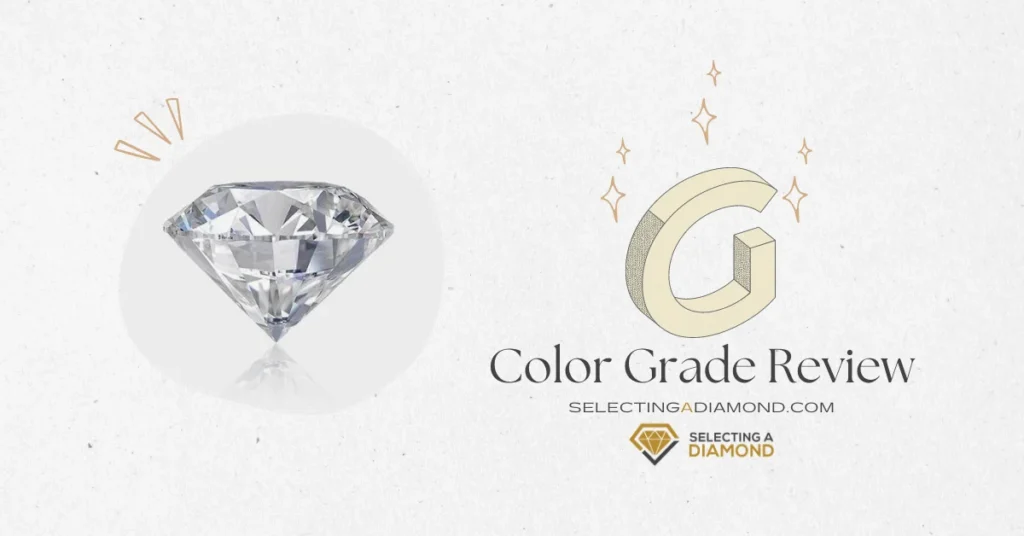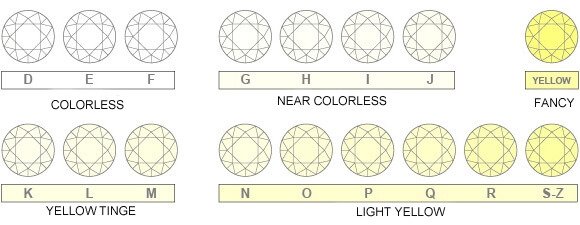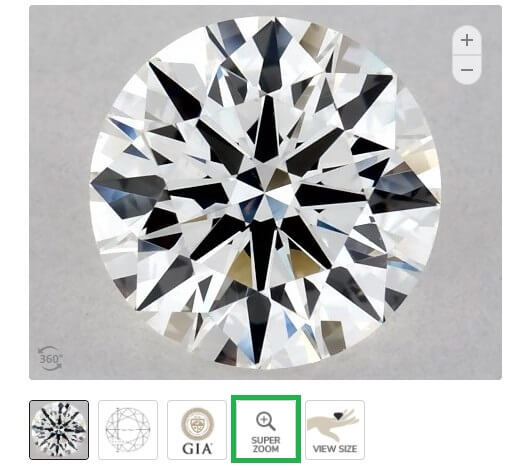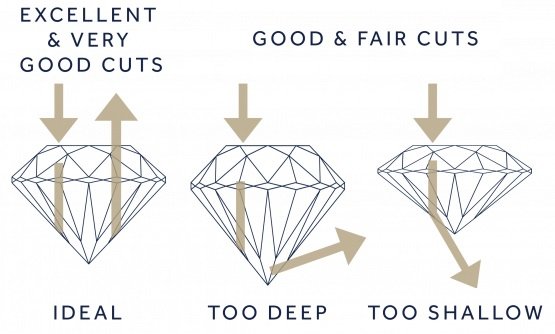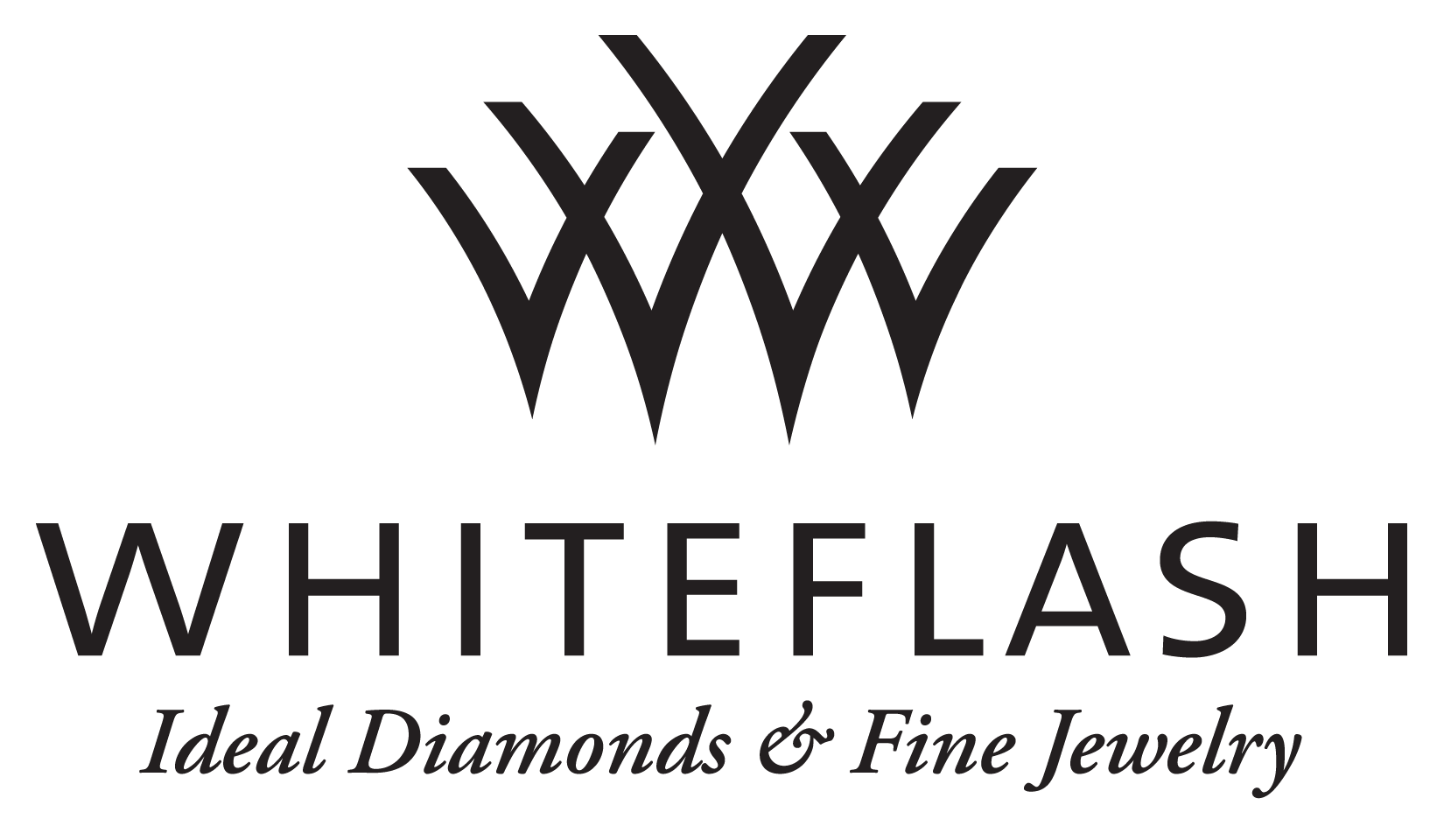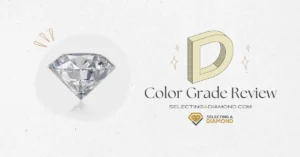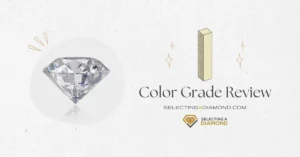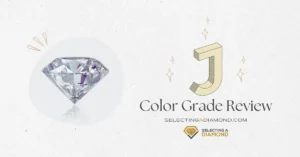Summary in a few lines:
Is G color diamonds good or bad?
They are indeed good, actually great! G color diamonds represent the perfect sweet spot, along with H color diamonds, for achieving a colorless appearance without breaking the bank. These diamonds are highly regarded for their balance of beauty and budget-friendliness.
G color diamonds fall into the ‘near colorless’ category, meaning any slight color it has is typically undetectable to the unaided eye, especially when set in a ring or piece of jewelry.
Here is a stunning 1 carat VS2 G color diamond on James Allen, or this astonishing A CUT ABOVE® on Whiteflash with G color as well, can you tell if they exhibit any yellow color?
G color diamonds offer a beautiful balance of high quality and value, making them a popular and smart choice for those seeking a diamond that appears colorless without the premium price of the highest color grades.
Let’s break this into pieces.
The overwhelming number of choices in today’s market, coupled with the endless stream of advice from friends, family, and online resources, can make any buying decision feel overwhelming.
This is especially true for diamond shopping, where the plethora of color options often leaves buyers in a state of confusion and difficulty to make a decision.
Many get confused about what different color grades mean, particularly when it comes to understanding terms like ‘colorless’ and ‘near-colorless’. A common worry is whether diamonds in the ‘not colorless’ categories will have a noticeable yellow tint.
Adding to this complexity, the G color grade sits at the very start of the ‘near-colorless’ range on the diamond color chart, making it challenging for buyers to tell its true color quality.
Advice from friends varies widely, some suggest opting for higher color grades like F color grade to completely avoid any hint of yellow, while others advocate saving money by compromising slightly on color and focusing on other aspects like cut or carat.
This conflicting guidance often leaves buyers unsure whether their choice is a matter of personal preference or an objective measure of quality.
To help clear the air, let’s begin with a quick overview of the diamond color chart, focusing particularly on where a G color diamond stands.
G Color Diamond: Where G Stands in Color Chart?
To fully grasp the G color’s position on the Diamond Color Scale, it’s essential to understand that the reputable Gemological Institute of America (GIA) grades diamonds from D to Z. ‘D’ signifies completely colorless diamonds, while ‘Z’ indicates diamonds with a light yellow or near-brown hue.
Each group of grades forms a color category. For instance, D, E, F are categorized as ‘Colorless’, and G to J fall under ‘Near-Colorless’, with G being the least tinted within this group.
G Color Diamonds rests perfectly on the top tier of the Near-Colorless range, having only a very subtle yellow tint as per GIA’s ranking.
Importantly, the visibility of this tint decreases in smaller G Color Diamonds. Conversely, as diamonds increase in carat weight, their color becomes more pronounced.
The smaller the G Color diamond, the less relevant the hue it becomes. However, diamond color is taken into consideration as their carat weight increases given that the bigger a diamond is, the more visible the color tints.
In other words, the larger the diamond (i.e. higher carat), the more sensitive it becomes to color. For instance, a 1-carat (or higher) H-color diamond will look “a bit” more yellow than a G color diamond.
However, this isn’t a hard and fast rule. Numerous factors influence a diamond’s color appearance, so this should be taken as a general guideline rather than an absolute standard.
G Color Diamonds Review: Is it Good or Bad?
Regarded as the ‘sweet spot’ on the GIA color scale, G Color Diamonds stand out for their exceptional balance of quality and value. Occupying the threshold just beyond the ‘Colorless’ category (D-F), these gems masterfully mask any hint of color.
This spot makes the G grade color virtually indistinguishable from colorless diamonds unless directly compared side-by-side with a diamond of a known color grade.
The only way to get the color grade right is to compare it with a known color set. Otherwise, you (or actually anyone else) can NEVER tell a diamond color by just looking at it.
Beyond color grading, several other factors influence the selection of a diamond. Notably, the choice of setting plays a crucial role.
When set in platinum or white gold, G color diamonds, and in some cases even H color stones, can present a less colored appearance, often mimicking the visual characteristics of higher-grade diamonds.
This unique trait of G Color diamonds, combined with their ability to appear colorless to the untrained eye and their relatively lower cost compared to D-F color diamonds, accounts for their popularity.
Particularly when set in the right metal, these diamonds offer a great blend of aesthetic appeal and economic advantage, typically ranging from 10% to 25% more affordable than their higher-graded counterparts.
Is G Color a Good Grade Choice?
Well, we can’t really say that the G color diamond is purely colorless, nevertheless, it’s not considered colored as well. If you’ve seen a G color before, we bet that you didn’t notice a single hue of yellow color in it!
The G Color is almost impossible to show any yellow color unless you compare it to a colorless diamond like D, under ideal light reflection conditions, actually you need diamonds to be at least 2 grades apart to be able to detect any color difference, so even G color will look the same (to the naked eye) when compared to an E color diamond.
When picking a diamond color grade, you shouldn’t go with the “highest possible” color grade nor an extremely low color grade.
With the first option, you’ll be paying way much more than you need, whereas the second option results in a diamond appearing yellow.
Generally speaking, we don’t recommend going less than an H-color diamond.
Feeling lost already?
Yep, this is why we believe it’s essential that you get your knowledge on diamonds from trusted sources, and then go hit an online reputable store like James Allen & Blue Nile and get your perfect diamond.
And if you happen to be looking for superior quality diamonds as we explained in this review, we recommend you to shop online at Whiteflash and explore their Premium Cuts & A CUT ABOVE fancy collections!
Does G Color Diamonds Look Yellow?
The short answer? No.
Here is a 1-carat, G color diamond on James Allen, do you see any yellowish appearance? We doubt.
You can even check it out under a 40x magnification from the options under the diamond image (as highlighted here):
Sometimes, the imaging technology & angle prevents seeing the color, so feel free to check other G colors diamonds with different images like this one on Whiteflash.
As mentioned above, this becomes even harder when the diamond is set on white gold or a platinum setting, such settings are known to hide any yellow color in a stone.
So in general, G color will not show any yellow color, it’s the first grade next to colorless group, making it more expensive compared to other grades in the same group (H-J) since people tend to go there
Let’s tell you one more thing:
If G color is that safe, doesn’t it make sense that the next color grade will have more or less the same characteristics? Because as we mentioned, differentiating grades is so hard and requires decent skills.
So, for untrained eye, both colors (G & H) will have almost the same effect, and when this comes with a setting color that’s known to hide colors, the mission to hide any color would be easily accomplished.
Should You Go Higher Than G Color?
Diamond salespeople will always try to convince couples to get the highest color to avoid any yellow appearance, ironically, this “highest grade” will be the highest color they have in store, and no need to go any grade higher!
So if they have an F color diamond matching your needs, F would be the best color, and when they have an E, E will be spectacular, you get the idea.
It’s worth mentioning, though, that a diamond color needs to be inspected by an expert (probably a 3rd party) and that it sure isn’t easily seen by the naked eye unless it’s compared with a known-grade diamond (as discussed on multiple occasions above).
This is where we must only rely on high reputation certification labs like GIA or AGS when picking a diamond, grades on certificates issued by these labs can’t be wrong!
How Popular is G Color?
From different sources around the web, here is a chart demonstration of the popularity of each diamond color grades, as of Q4, 2023:
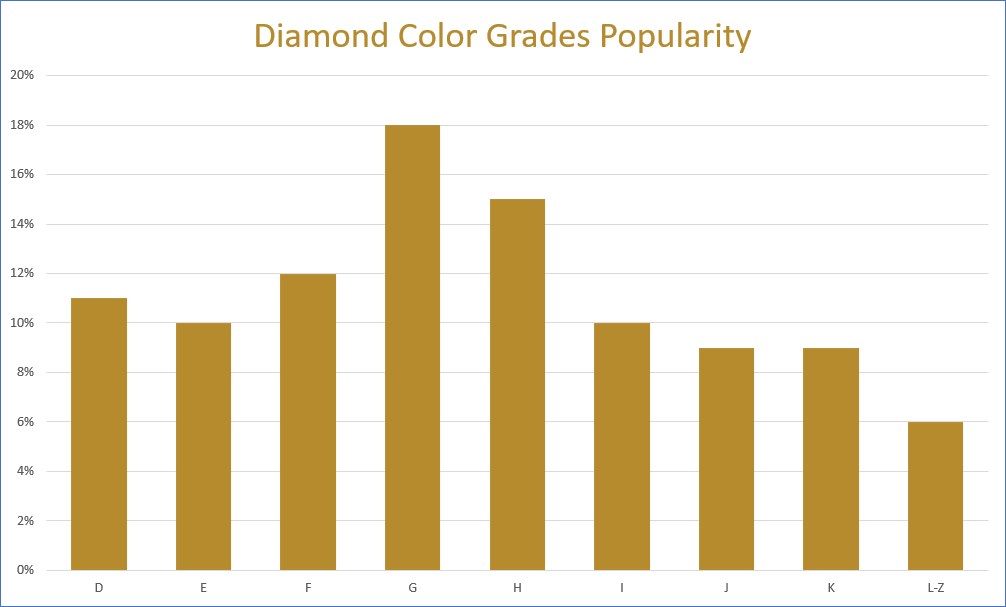
In the market, numbers aren’t that far.
We ran a search on James Allen, and out of 330000 diamonds, here is a breakdown for round diamonds in different color grades (all cut grade, all carat, and all clarity grades):
D 37600
E 37000
F 40000
G 48400
H 46300
I 49400
G color is a clear winner in popularity, we did the same check on Blue Nile, same results, G won with around 5000 more than next color (which is H, will see shortly why this is not a coincidence).
Insane numbers here right? We’re talking about more than half a million diamond at just two stores! No wonder we always recommend to shop diamonds online, and we also believe you should check our unbiased review for James Allen, as well as Blue Nile.
G & Neighboring Colors: F vs G vs H Grades Difference
It’s not only us who believe so, but according to James Allen, a renowned diamond merchant dealing with a vast inventory, discerning color differences between adjacent diamond grades is quite challenging.
Generally, when comparing color between two diamonds, the diamonds need to be at least two color grades apart to even begin to see a difference
Typically, to notice any color variation between diamonds, they need to be separated by at least two grades. F, falling into the colorless category, is slightly more colorless than G, which is on the higher end of the near-colorless scale. H, meanwhile, sits squarely in the middle of the near-colorless range, making it subtly different in color from both F and G.
When comparing two diamonds side by side, such as F vs G or G vs H, it’s unlikely that an untrained eye will detect any color difference. This is true even for loose diamonds, where setting differences are not a factor.
Even when comparing diamonds two grades apart, like an F and H grade diamond, the difference in appearance can be so subtle that they might seem only one grade apart.
Generally, only a gemologist or an experienced jeweler can identify these color distinctions, and even then, only under optimal conditions.
So, is your girl a gemologist by any chance?
In summary, choosing a diamond in the F to H color range is often a matter of personal preference rather than noticeable color difference, as all grades in this range are considered beautiful and appear colorless to the untrained eye.
Having that said, it becomes a matter of how budget-friendly is each of these grades, when we acknowledge that they look almost identical to the naked eye.
G vs Similar Color Grades: Visual Comparison
When it comes to comparing the colors of diamonds, especially those set in rings, the task becomes more challenging. This is because the visual differences between diamond colors are not as pronounced in normal settings as they are under the intense magnification and advanced imaging technologies available at retailers like James Allen.
It’s important to remember that various factors can influence how a diamond’s color appears. For instance, an H color diamond in a round cut may have a slightly different appearance from a cushion cut diamond of the same grade.
To facilitate a more accurate comparison, let’s fix the other Cs of diamonds – cut, clarity, and carat. For this purpose, consider three images from James Allen, each showing a 1 Carat Diamond in F, G, and H color grades respectively.
To examine these diamonds in finer detail, including 360-degree views, you can refer to specific links for the F color on the left, the middle G color, and H color diamonds on James Allen’s website.
With each diamond grade’s price differing between $500 & $1000, it’s worth delving into these comparisons to understand where you might be able to save money without compromising on the diamond’s visual appeal.
G Color Diamond Price Range
Color is only one player in a game of the big four (and much more if we can all diamond characteristics)! And all these characteristics influence diamond prices of course.
We will be fixing the following factors: Cut, Clarity, Carat, Polish, Symmetry & Fluorescence, and only changing the color for the sake of noticing the price difference/change between H, G, and F color diamonds.
Being the largest retailers globally, we ran several searches on Blue Nile & James Allen with the following characteristics:
Carat: 1
Cut: Excellent (Ideal)
Clarity: VS2
Polish: Excellent
Symmetry: Excellent
Fluorescence: None
Fix all the above factors and start changing the color, once with an H, another search with a G, and the third one with an F.
We took the liberty to try them all for you, you can see all results below (outliers excluded).
Blue Nile Prices for H, G, F Color Diamonds:
H Color: $4.0k – $5.6k (average $6.8k)
G Color: $4.4k – $6.2k (average $7.3k)
F Color: $5.0k – $7.0k (average $8.0k)
James Allen Prices for H, G, F Color Diamonds:
H Color: $4.1k – $5.5k (average $6.6k)
G Color: $4.3k – $6.0k (average $7.1k)
F Color: $4.9k – $6.7k (average $7.7k)
We can clearly note that:
- James Allen’s prices are slightly cheaper than Blue Nile.
- In jumping from H to G color, the average price increases by around $500.
- And most importantly, if you calculate the price difference between G and F color, this jump will cost you $600-$700 on average!
This is no magic, it’s simply because you’re moving from a Near-Colorless grade to a Colorless grade!
Best Clarity for G Color Diamond
Clarity is a predetermined ranking of how internal (and sometimes external) blemishes affect the value of a diamond. There are six significant categories that determine the clarity grade of a diamond:
When it comes to Clarity, we always recommend getting an eye-clean diamond, this usually appears in most diamonds with SI1 clarity and All VS2 (and above) grades, as this grade of diamonds has slight inclusions that are almost invisible unless examined properly under magnifying equipment.
Also, read: Diamond Inclusion Chart – How it Affects Clarity?
As we will see in the recommended Carat for G grade, the G color is absolutely a great select for relatively high-carat diamonds, i.e. diamonds +1 carat.
This utterly means that for +1 carat, the diamond table will be larger and inclusions would be more visible, that’s why we recommend getting VS2 in G color diamonds.
Best Cut for G Color Diamond
Diamond cut refers to the proportions of the parts of the diamond, and how well the diamond facets reflects light when exposed to direct light.
Diamond cut is considered to be the most important job of artists and workmen who craft the diamond to make it as symmetric as possible, as well as proportional & polished well to reflect the maximum amount of light.
Also, Read: Diamond Cut vs. Diamond Shape & Most Popular Shapes
Regarding the Cut, always go with an excellent/ideal cut, even if you’re on a strict budget, go lower in carat to guarantee an excellent cut, always keep this in mind: Better/proper cut means more brilliance and better light reflection!
Best Carat for G Color Diamond
Also called Carat Weight, functions as a standard unit of measurement for the weight of diamonds. A carat weight equals 0.20 grams.
With that being said, Carat doesn’t always mean size, a diamond with high carat weight, however, a “good” cut will lose all of its weight in its depth, compared to lesser carat but an “ideal” cut which means a lower carat but “looks” larger.
As for carats, this totally depends on your budget, however, remember that higher carat sizes mean more visible inclusions, which means you should go a little above SI1 in some cases.
If you’re getting a diamond with less than 1 or even 1.2 carat, in lots of cases, you can go lower to H color and we’ve discussed that in deep details in another post, but in short, color is less visible on diamonds less than 1 carat.
Let’s not forget the shape of the diamond, it sure helps in masking the inclusions. We endorse round cut G-colored diamonds, as this style of cutting separates light, allowing the sparkle to conceal the diamond’s flaws.
Summary: Is G the Best Diamond Color Option?
As we saw, G is a great color pick to guarantee a diamond without any yellow color.
People wouldn’t be able to tell what color a diamond is by just looking at it, even experts!
If you want to make the best bang for your buck, we recommend going with H color in diamonds around 1.2 carat or less, as it’s almost identical (to naked eye) to G color, and this becomes more prominent when mounting it on a white gold or platinum setting.
We hope that whatever your choice is, that we at least helped clarify things out for you and that this article was pretty much enlightening for you!
Still not sure where to buy your diamond?
We always recommend shopping diamonds online and created a Full guide to shop diamonds like a Pro.
Among online retailers, here are our favorite stores click their logo to visit store
-
James Allen:
Our favorite online store, best diamond imaging technology available today, comes with the largest collection with more than half a million loose diamonds.
-
Blue Nile:
Widest collection of loose diamonds of all sizes, great imaging technology for most of their inventory (hundreds of thousands of diamonds), great customer support.
-
Whiteflash:
Home Of A CUT ABOVE® Super Ideal Diamonds, they stand out from the crowd by offering premium diamonds cuts, tailored to those who love the details, at great prices too.

